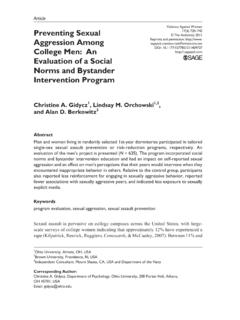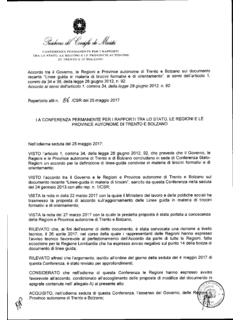Transcription of social norms approach-short - Alan Berkowitz
1 An Overview of the social norms approach Alan D. Berkowitz Independent Consultant To be published as Chapter 13 in L Lederman, L Stewart, F Goodhart and L Laitman: Changing the Culture of College Drinking: A Socially Situated Prevention Campaign, Hampton Press. The social norms approach - 2. Introduction social norms is a theory and evidence-based approach to addressing health issues that has gained increasing attention. social norms interventions have been successful in reducing alcohol and tobacco use in college and high school populations, and has promise as an intervention to address violence and social justice issues. As a result of these successes, practitioners in the field of social norms have received national recognition for their work and social norms programs have received a number of best practice awards from Federal agencies. Currently social norms interventions are being funded by the United States Department of Education, the Department of Justice, the Centers for Disease Control, state health departments, private foundations, and in some cases, the beverage industry.
2 In addition, four large outcome studies funded by the National Institute on Alcoholism and Alcohol Abuse (NIAAA) are currently underway that will provide additional data on the effectiveness of this approach . This chapter provides an overview of the theory of social norms , a brief history, reviews relevant research, presents evidence of successful outcomes, and concludes with a discussion of challenges and emerging issues. The Theory of social norms social norms theory describes situations in which individuals incorrectly perceive the attitudes and/or behaviors of peers and other community members to be different from their own when in fact they are not. This phenomenon that has been called pluralistic ignorance (Miller and McFarland, 1991; Toch & Klofas, 1984). These misperceptions occur in relation to problem or risk behaviors (which are usually overestimated) and in relation to healthy or protective behaviors (which are usually underestimated).
3 One of the effects of pluralistic ignorance is to cause individuals to change their own behavior to approximate the misperceived norm . This in turn can cause the expression or rationalization of problem behavior and the inhibition or suppression of healthy behavior. This pattern has been well documented for alcohol, smoking, illegal drug use, and a variety of other health behaviors and attitudes, including prejudice. In the case of ATOD use, perceiving the norm to be more permissive than it really is can facilitate increased use and provide a rationalization for problem users to justify The social norms approach - 3. their own abuse. The literature on social norms and the supporting research has been thoroughly reviewed by Berkowitz (2003A) and Perkins (2002, 2003A). Most of the research conclusions in this chapter are based on the evidence presented in these literature reviews. College student use of alcohol can provide a case example.
4 There is extensive research suggesting that most college students overestimate the alcohol use of their peers ( , there is pluralistic ignorance with respect to alcohol use. This overestimation results in most moderate or light-drinkers consuming more than they would otherwise and may also encourage non-users to begin drinking. Heavy users of alcohol are even more likely to believe in this misperception and use it to justify their heavy drinking. This latter case is an instance of false consensus ( falsely believing that others are similar when they are not). The extent to which alcohol use is misperceived has been strongly correlated with heavy drinking in many studies. Similar patterns have been documented for tobacco use. False consensus and pluralistic ignorance are mutually reinforcing and self-perpetuating. In other words, the majority is silent because it thinks it is a minority, and the minority is vocal because it believes that it represents the majority.)
5 Providing accurate normative feedback is one way to break this cycle, which can otherwise create a self-fulfilling prophecy ( , everybody drinks more because everybody thinks that everybody drinks more). social norms theory predicts that interventions to correct misperceptions by revealing the actual, healthier norm will have a beneficial effect on most individuals, who will either reduce their participation in potentially problematic behavior or be encouraged to engage in protective, healthy behaviors. Thus, information about healthy drinking norms and attitudes will encourage most individuals to drink less or not at all (which is more consistent with their underlying values and intentions), and also challenge the reasoning that abusers use to justify their drinking. All individuals who misperceive contribute to the climate that allows problem behavior to occur, whether or not they engage in the behavior. Perkins (1997) coined the term carriers of the The social norms approach - 4.
6 Misperception to describe these individuals. Thus, social norms interventions attempt to correct the misperceptions of all community members whether they actually engage in the problem behavior or not. social norms theory can also be extended to situations in which individuals refrain from confronting the problem behavior of others. Thus, individuals who underestimate the extent of peer discomfort with problem behavior may refrain from expressing their own discomfort with that behavior. If the actual discomfort level of peers is revealed, these individuals may be more willing to confront the perpetrator(s) of the behavior. Recent research on homophobia, for example, suggests that most college students underestimate the extent to which their peers are intolerant of homophobic remarks (Bowen &. Bourgeois, 2001; Dubuque et al, 2002) and may be willing to confront these remarks when made aware that peers also feel uncomfortable ( Berkowitz 2002A; 2003B.)
7 Similarly, men underestimate other men's discomfort with sexist comments about women and are more willing to confront perpetrators when they believe that other men feel the same way (Fabiano, et al, submitted for publication). The term social norms as used here must be distinguished from public health approaches that attempt to change social norms . In this chapter, the term social norms approach refers to the correction of misperceptions of social norms rather than attempts to change norms when the majority of a population already behaves in a healthy manner and/or has healthy attitudes. Thus the goal is to reveal and enhance already existing healthy norms that have been underestimated and weakened. While there may also be social and public health issues for which actual norms need to be changed, this is not what is meant by the use of the term social norms here. Because both meanings of social norms are widely used and have different connotations they must be carefully distinguished because they refer to different phenomenon and presuppose different models of change.
8 The assumptions of social norms theory are presented in Table 1. (Insert Table 1 Here). The social norms approach integrates a variety of concepts and phenomenon that have been well documented in the social science literature. For example, the social psychological phenomenon of pluralistic ignorance and false consensus have been extensively studied and provide a coherent The social norms approach - 5. explanation of why individuals act differently from how they feel (in the case of pluralistic ignorance). or rely on a self-serving bias like false consensus to justify problem behavior. social norms interventions can also be understood in terms of cognitive dissonance theory, another well-established framework within the social science literature. Providing accurate information about norms creates cognitive dissonance by informing those who are in the misperception that what they believe is wrong, that those who are pluralistically ignorant are in the majority and that those who are in false consensus are in the minority.
9 Introducing cognitive dissonance can catalyze a process of change if information about the true norm is introduced in a way that is believable and credible. social norms relies on indirect methods of persuasion that provide accurate information about what people think or do without telling them what they should do. The information provided helps the recipient to act differently without feeling that this change is being imposed from without. This methodology is consistent with a variety of social psychological approaches to change that have been empirically supported (Kilmartin, 2003). A History of the social norms approach The social norms approach was first suggested by myself and H. Wesley Perkins based on research conducted at Hobart and William Smith Colleges in the 1980's ( Berkowitz & Perkins, 1987, Perkins and Berkowitz , 1986), although it was initially referred to by different names. It has since been implemented at all levels of prevention: primary or universal with entire campus or community populations, secondary or selective with particular subpopulations (such as Greeks and athletes) and tertiary or indicated with individuals.
10 These approaches use a variety of methodologies to provide normative feedback as a way of correcting misperceptions that influence behavior. The first social norms intervention was initiated in 1989 by Michael Haines at Northern Illinois University (Haines, 1996; Haines & Barker, 2003; Haines & Spear, 1996). Haines expanded on the theory of social norms by applying standard social marketing techniques to present the actual healthy norms for drinking to students through specially designed media. This approach has been called social norms marketing (SNM) to distinguish it from traditional social marketing, which does not contain The social norms approach - 6. information about actual norms . The social norms marketing campaign at NIU is an excellent example of universal prevention, because it reached the entire population of a community. It has been in existence since 1989 and has produced significant increases in the proportion of students who abstain (from 9% in 1989 to 19% in 1998), and in the proportion of students who drink moderately (from 46%.)










